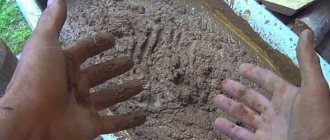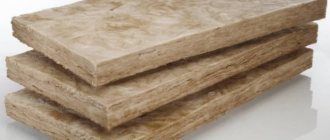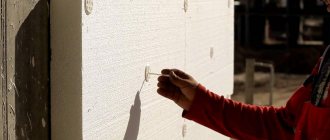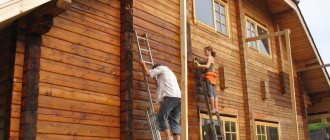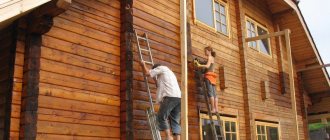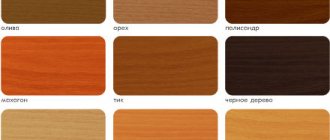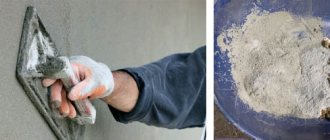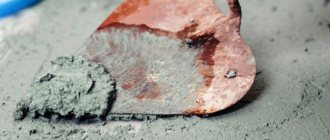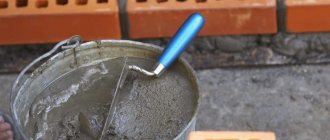Sand is an integral part of most building mortars and materials. Therefore, the quality of the sand mass, the degree of its purification and uniformity can greatly change the characteristics of the masonry or plaster mass. Depending on the purpose and task, you need to choose the right type of sand filler.
Selecting sand for the desired type of plaster
Most experts consider the most rigid and durable mortar based on quarry sand mass. There is a certain amount of truth in this. But high strength is not always the main advantage of finishing building materials.
Raw quarry sand, like most man-made rock crushing products, is cheaper and more readily available. Both river and quarry versions of sand filler have a lot of features that can affect the quality of the plaster in completely different ways.
What are the benefits of using river sand for plaster?
River sand grains are highly homogeneous; they almost always have high roughness, round shape and stable size. The grain size of such material largely depends on the place of its extraction and can be large or medium fraction. The ratio and spread of grain sizes within one batch is almost unchanged. River sand is ideal for high-quality plaster, which has excellent sound and thermal insulation. Plaster based on material from the river perfectly allows air and water vapor to pass through. The density of such plaster is lower than for plaster mixtures based on quarry sand or an artificial product. This plaster has the best plastic characteristics and is easily applied to the prepared surface.
Due to the specific properties of the surface of rounded grains of river material, cement grains “stick together” with the sand mass much more easily during the hydration process. But plaster mortar based on cement and river material adheres much worse to an unprepared wall surface. The medium and fine fraction of river sand is better suited for putty material than quarry sand filler. Plaster mortar on river filler, prepared with excess cement content, will not lead to the development of cracks.
Using quarry sand
The composition of the mountain sand mass differs greatly, depending on the place of extraction, in the content of undesirable impurities, such as metal oxides, complex silicon salts and, above all, clay. In the composition of quarry material, the grains have sharp edges, and most importantly, the grain size ratio is very different. One mass is full of both large and small grains, so dry quarry material has a higher bulk density.
Plaster on sand from a quarry will be much denser and heavier than mortar on river material with the same ratio of components. The quarry option is well suited for preparing a plaster solution used for spraying - the first primer layer for walls, on which all subsequent layers are laid.
The grains of quarry sand filler have sharp edges, which make it possible to perfectly hold the plaster solution on a brick or even concrete wall surface. In some cases, quarry sand is washed to remove clay and the shape of the grains is changed by special treatment, making them flatter and sharper. This filler has increased adhesion to concrete and is often used as a filler for primers called concrete contact.
Clay-free, but not graded, quarry grain is ideal for heavy concrete castings or masonry mortar. This building material has a rigid character and holds the geometry of the wall masonry well. In a plaster solution, it can be added in a higher ratio; this will not reduce the mechanical properties, but may increase cracking.
Fractionated, washed sand from a quarry can be used for plastering in the same way as regular river sand, provided that additional polymer additives based on acrylic resins or polyvinyl acetate emulsion are used. Large fractions are practically unsuitable for interior plastering of walls.
Types of filler for cement-sand mortar
Sand aggregate is divided into types according to the size of grain fractions:
- coarse-grained with grain size from 2 to 4 mm;
- medium fraction with grain size from 0.5 to 2 mm;
- fine-grained with grain size from 0.25 to 0.5 mm.
To plaster walls with your own hands with a cement-sand mortar, medium-fraction sand is usually used. It must be of high quality, without impurities. How uniformly and smoothly the layer will lie depends on the size of the sand grains. The smaller they are, the easier it will be for you to work with the solution. It is perfect for finishing leveling floors or walls. For the first (rough) layer of plaster, coarse sand is used. To prepare the plaster mortar, it is worth purchasing already cleaned and sifted sand.
It is important to know that even with high roughness, the finer it is, the greater the amount of binders and water needed to envelop it.
Special types of sand for plasters
A large number of components for concrete or plaster mixtures are produced from crushed rock waste. After grinding, washing and fractionation, heavy granules with grains of arbitrary shape are obtained.
The adhesion of such grains to the cement grain is not always uniform and can cause significant shrinkage. Therefore, for plastering work, such sand filler is subjected to thermal hardening, which increases the roughness and surface area of the grains. In some cases, artificial sand is treated with dry powder adhesives, which increase adhesion to the base, even in conditions of low water content in the solution.
High-quality rock sand is perfect for any plaster; it is very often used instead of expensive quartz sand in a variety of ready-made cement-based mixtures. It is better not to use sand of unknown origin for household work due to the possible unfavorable environmental content of the material.
GOST standards
Not only various products, but also natural materials are subject to standards and regulations. To find out whether sand quarry filler meets GOST requirements, there are various tests.
The grain composition of the sand filler is determined according to GOST 8736-93. To do this, it is sifted through sieves having cells of different sizes: 0.16; 0.315; 0.63; 1.25; 2.5 and 5 mm.
The resistance of sand to the influence of alkalis is also determined. This requirement must be taken into account when producing concrete. There is a list of minerals that cannot be used for building mixtures.
According to GOST 8735, quarry construction sand is always treated with NaOH (sodium hydroxide) solution for testing. This is a test for the presence of organic impurities. As a result of the test, he will not change the color of the mixture to a darker one or one that matches the sample.
Completion
Any of the available product options can be used in plastering walls. For soil and spray it is better to use quarry sand; for subsequent layers of wall plaster, experts advise using building materials from the river.
For exterior finishing, filler from a quarry will be more preferable, provided that at least part of the clay and rock is washed and removed. The finest fraction of river filler is ideal for making homemade putty from acrylic water-soluble paint and glue.
Sometimes, in order to equalize the overall characteristics, mixes of different versions of sand filler are used. This will make it possible not to depend on the individual characteristics of one of the sands and reduce the cost of production of cement-based wall finishing materials.
Source
Plastering walls is common in construction. It allows finishing of the premises and determines the quality of repair activities. When finishing the walls yourself, you need to understand what kind of sand is needed for plastering the walls.
Sand is a universal raw material used in various activities. When carrying out plastering work, sand obtained from quarries and river origin is used. There is no consensus among builders discussing what is best.
Each type, depending on the production technology, has individual characteristics that affect the strength properties of the cement composition made on its basis. Let's consider sand for plastering walls, features associated with its origin, and scope of application.
Regarding what kind of sand is needed for plastering - river or quarry, the opinions of builders differ significantly from each other
Composition of the plaster mixture
When performing repair and finishing work in apartments and houses, plaster is perhaps the most common material. The quality of finishing directly depends on the quality of the source material and adherence to the preparation technology. In this article we will take a closer look at an important component of plaster - sand, on which the final result of the repair largely depends.
The plaster solution is a mixture of the following components:
- Binder. These are cement, lime and gypsum. They are used in solution both individually and in various combinations with each other. Give the finished solution viscosity and plasticity. The rate of hardening of the solution, the strength and water permeability of the plastered surface directly depend on the binders.
- Inert filler. This is, first of all, sand. You can also use slag or stone chips as a filler. The quality of the filler affects the final result no less than cement and lime. The quality of adhesion of the mortar to the wall, strength, thermal insulation and sound insulation characteristics, and the appearance of the plastered surface depend on it.
- Water.
To improve the properties of the solution, various polymer additives are used. You can, for example, add wood glue to gypsum plaster. It increases the setting time, thereby making the work easier.
Problem of choice
When discussing the issue of using raw materials for wall finishing, developers are faced with different opinions from builders. Let's consider what arguments are given by the debating parties:
If plastering is being done, high-quality sand must be used. Which type should you prefer - one that increases the strength characteristics of the solution or one that is more convenient to use? Let us dwell in detail on the characteristics of materials related to the production features, and consider how to properly perform sifting.
Characteristics
Upon superficial inspection, the sand massif is no different in appearance. However, experienced builders, having examined the material and rubbed it in their palms, are ready to make a conclusion about its suitability for performing specific construction tasks.
Sand is an integral part of most building mortars and materials
Let's consider the indicators characterizing the mechanical and physical properties of the sand composition:
Depending on the extraction method, the following types of sand massif are distinguished:
Let us dwell in more detail on the quarry and river species. Let's figure out what kind of sand is needed for plastering walls.
Depending on the purpose and task, you need to choose the right type of sand filler
Quarry origin material
The name of quarry sand clearly indicates the area of origin. It naturally contains clay and rocky inclusions, has a limited area of use, and is used for:
Modern construction methods make it possible to improve the characteristics of raw materials obtained by quarrying directly at the mining site. Water washing is used to free the sand fraction from clay inclusions. The resulting alluvial fraction, or washed fraction as it is called, is successfully used for plastering walls. Clay inclusions should be removed from the mass by sifting.
Unlike river material, quarry material settles faster to the bottom of the container and requires regular mixing. It is possible to use quarry sand with the addition of material of river origin for plastering walls.
If high-quality plaster is needed, the sand that is offered to be purchased from the quarry must be washed and sifted.
River sand is ideal for high-quality plaster, which has excellent sound and thermal insulation
Sand washed up from rivers
This construction raw material is obtained using a dredge. The sand composition contains no clay particles or foreign mineral impurities. This significantly expands the scope of application.
River sand particles are characterized by the following parameters:
The material is characterized by minimal variation in the geometric sizes of particles in any of the supplied batches. River sand is an ideal material for high-quality wall plaster, providing high thermal insulation characteristics.
After hardening, a plaster solution based on river sand provides excellent air exchange and the escape of water vapor from the room. The plaster has a reduced density compared to a composition based on material obtained from a quarry. It is quite plastic and has good contact with the surface of the walls.
The radial shape of the particles ensures good bonding with cement during the hardening process. The plaster composition has poorer contact with the surface being treated without special preparation.
The optimal fraction of the material obtained using a dredger is a particle size of 1.8 to 2.2 millimeters. The absence of shrinkage after drying of the cement composition prepared on its basis allows the use of sand for finishing work.
Quarry and river sand
The choice of filler depends on the thickness of the layer to be applied.
For finishing work with a thin layer, it is best to use river sand. Compared to other types of this material, it is environmentally friendly. It is extracted from the river bottom by a dredge. This sand aggregate contains no clay grains and virtually no stones. With an average size of up to 2.2 mm, it does not shrink, which makes it possible to use it for plastering walls and masonry.
If rough finishing of the walls with a thick layer is intended, then material of river origin is not recommended. As a result of many years of exposure to water, the sharp edges on the grains of sand have been erased. And therefore it consists of small smooth balls that do not adhere well to the base and to each other.
Quarry sand can provide a stronger coating with good adhesion. This ensures a long service life of the finish. It owes its origin to weathering. Quarry sand is formed from quartz rocks, mica and feldspar. It is mined by open-pit mining from rocks. The cost of such filler is significantly lower than river filler. When purchasing plastering material, be sure to check whether it has been washed or cleaned.
Types of sand
You need to choose which sand to use for plastering, taking into account the characteristics of each type.
Which sand is best for plastering is determined depending on the work being performed. When choosing a filler, consider the thickness of the intended layer. If you need a thin layer, then it is better to use river sand, since it contains less clay and stones, and it lies more evenly. For the initial finishing of the walls, it is better to take a thick layer of quarry sand. It has more sharp edges, the bonding of the solution is stronger, and therefore more durable. Plaster with quartz sand is used in interior design.
Choosing a filler for plastering walls
Sand can be called a universal material, as it has found its application in all construction work. As you know, it can be river or quarry. Experts differ on the issue of choosing the right sand for plastering. Some say that river water is preferable, since it does not contain foreign impurities, clay and foreign debris. This results in a better quality solution and stronger adhesion to the wall surface. Others believe that the presence of clay particles in the quarry material gives the mixture plasticity, so it is easier to apply to the base. If you are doing ordinary renovations in an apartment, then quarry filler is quite suitable. It turns out that one type of filler makes the solution durable, and the other makes it easy to use. Which one you should choose, decide for yourself depending on your needs.
It is strongly recommended not to use sand filler that contains dust, clay and silty impurities. It should be free of lumps and clean. To do this, the material must first be sifted.
Material calculation
When doing repairs yourself, you need to know how to calculate sand and cement for plaster. When calculating materials for plastering, the quality of the surface (material and curvature of the walls), mixture parameters, and texture of the final coating are taken into account.
Component ratio. Depends on the brand of cement used, the sand fraction, and the required quality of the prepared solution. When making a standard mortar, cement and plaster sand are used in a ratio of 1:3. If lime is added to the solution, then the ratio is one part cement and lime, 5-6 parts sand.
Material consumption. The more irregularities on the surface, the greater the consumption of materials. To reduce the consumption of plaster, the walls are primed, and a construction mesh is used at the junction of materials of dissimilar structures.
Layer thickness. It is calculated by determining the surface difference relative to the vertical. The thickness of the plaster application ranges from 3-6 cm.
For example: 3 beacons are installed, deviations along the plane are 2.3.5 cm. Calculation in this case: (2+3+4)/3=3 cm - this is the thickness of the plaster layer.
The video in this article will help you understand the use of different types of sand for wall finishing.
Clay and lime plaster
Clay plaster with the addition of organic fibers and lime has recently become increasingly fashionable for finishing indoor walls. In addition to a healthier environment, walls finished with clay provide a specific microclimate that is more suitable for people with allergic diseases.
It is best to knead on unwashed river sand for thin clay. Fat plastic clays are mixed using quarry material. The selection of the optimal ratio of components largely depends on the quality of the materials, so it is quite difficult to offer exact proportions. The technology for preparing and applying plaster to walls is similar to cement mixtures; for the finishing layer you will need to add a small amount of lime paste.
This is interesting: Which wallpaper is better: vinyl or non-woven?
Applying plaster with sand
The application of plaster containing sand has a number of features. First you need to do:
The pattern on the surface is leveled using a spatula. After the surface has completely dried, wax and special toners are applied on top.
When decorating walls, the manufacturer's instructions determine the specifics of using decorative plaster: in one case, the composition is mixed to evenly distribute the fillers, in another, dilution with water is required.
Decorative plaster
Decorative plaster with sand is a type of interior decoration. When making decorative plaster, river or quartz sand is used, as well as reflective components and additives that determine color. Depending on the type of surface, types of plaster are divided into matte and pearlescent.
This type of wall decoration is environmentally friendly; when using additional components, it is resistant to moisture, mold, and resistant to destruction during operation.
Plastering sand, which is part of decorative plaster, is used to create patterns on the surface of walls: sand whirlwinds, dunes, special visual effects that are created using stencils and brushes.
Photo of decorative sand finishing:
Proportions in solution
Sand is added to dry finishing mixtures as a filler; cement, lime, gypsum or clay can play the role of a binder.
The aggregate directly affects the specific gravity and strength of the finish, particle adhesion, shrinkage, thermal insulation properties and appearance. According to the last two indicators, it is significantly inferior to other materials, such as pumice, marble chips, and slag. In addition, sometimes it contains so-called zeolites, which lead to the formation of efflorescence on the surface of the plaster.
For the above reasons, builders try not to use mixtures with sand as finishing materials. But due to the fact that it is the most accessible and, as a result, cheapest filler, it is used in all other cases.
Barite sand for X-ray protective plaster is described in detail in our article.
The two main types of plaster finishing with sand, which are most often found in practice in practice: cement-sand and clay-sand.
The ratio of the amount of binder and filler for cement-sand finishing mixtures:
- Spray 1 to 2.5-4
- Primer layer 1 to 2-3
- Covering. 1 to 2
Also for a mixture based on clay and sand:
- Spray 1 to 3-5
- Primer layer. 1 to 3-5
Cement-sand plaster is used in places with high humidity, because gypsum absorbs water, and also when its use is justified from a financial point of view, for example, when it is necessary to level a large area of noticeably curved walls.
The amount of bulk aggregate added to the clay depends on its fat content. Clay-sand mortar is often used to decorate brick kilns, since under the influence of high temperatures this plaster gains strength and becomes like a brick. In this case, asbestos and lime are often added to the mixture in an amount of about 10% for each component.
Clay has a high thermal conductivity, so clay-sand mortar is not recommended for use as a primer layer. This plaster is more suitable for covering.
Material price
It should be noted that with a large volume of work, it is more profitable to make plaster from a mixture of cement and sand yourself. The price of cleaned and washed sand is higher than that of untreated sand. The most economical option is to buy unwashed, unsifted quarry sand; the cost of river sand is higher than quarry sand, quartz sand is much more expensive.
Cost of sand per ton without delivery:
It is impossible to say unequivocally which sand is better for plastering wall surfaces. Each type is used taking into account recommendations for use, layer thickness, type of finishing surface, and price of the material.
Source
